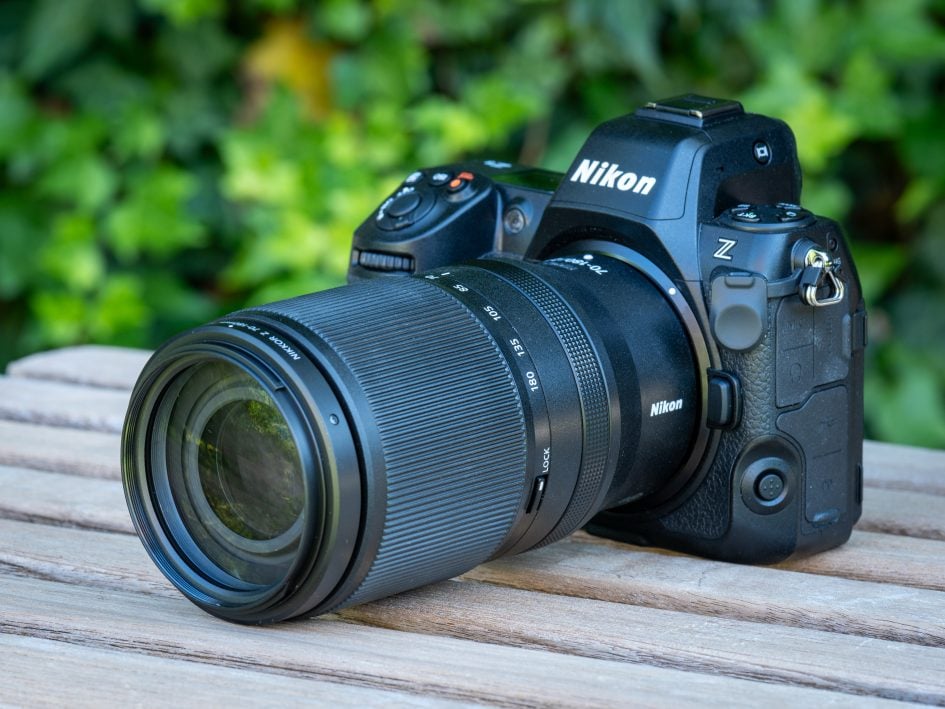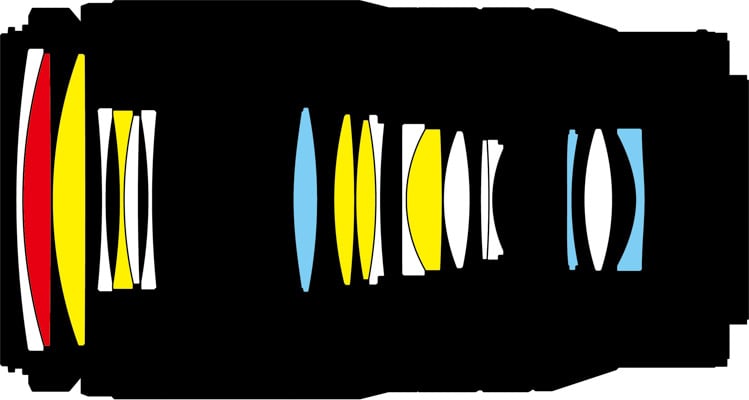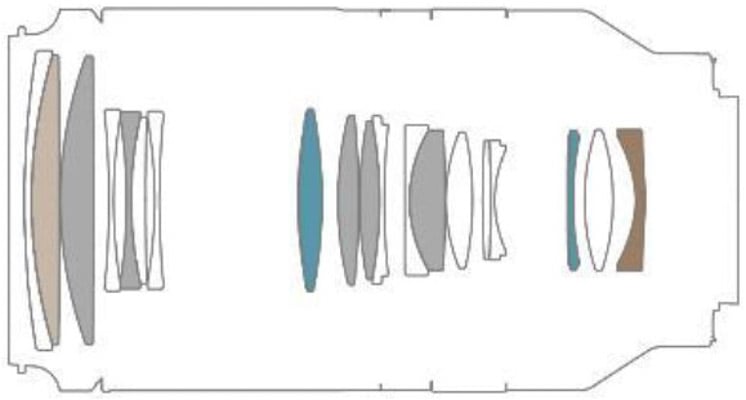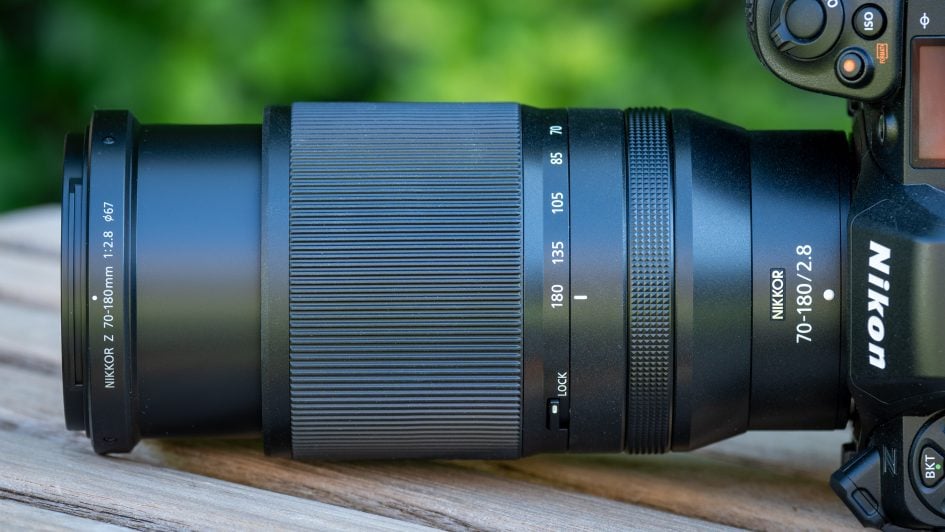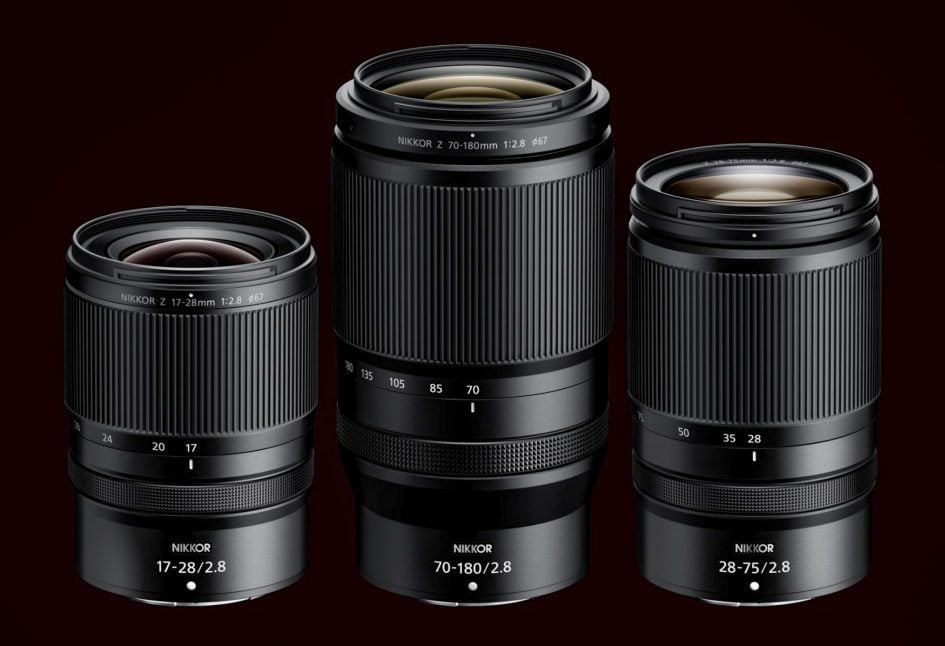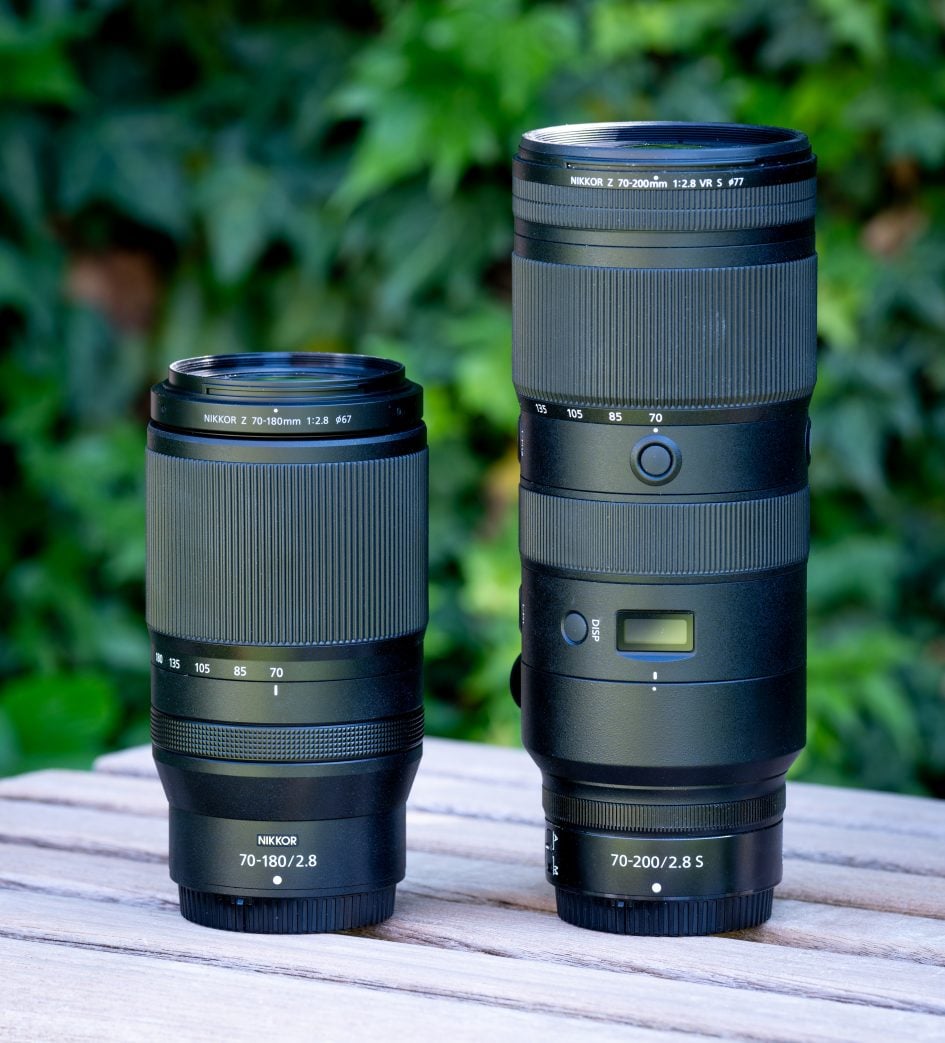Nikon Z 70-180mm f2.8 review
-
-
Written by Thomas
Intro
The Nikon Z 70-180mm f2.8 is a compact and lightweight telephoto zoom designed for Nikon Z-series mirrorless cameras and corrected for full-frame sensors. Announced in June 2023, it completes another “trinity” of zoom lenses for Z-mount with a fast f2.8 focal ratio: the Z 17-28mm f2.8 and the Z 28-75mm f2.8. All three lenses are smaller, lighter and less expensive than Nikon’s S-line professional zoom lenses but they cover a slightly smaller range of 17-180mm versus 14-200mm.
Physically, the Z 70-180mm f2.8 shares the same small 67mm filter thread with the shorter zooms and it is only 151mm long – but extends when zoomed in to 180mm focal length. At 795g it is pretty lightweight and can go down to a maximum magnification of 1:1.9 at 70mm focal length. Sadly it lacks optical image stabilization and relies solely on the sensor based stabilization of Nikon’s full-frame Z-mount bodies. Which is a pity if you want to use the lens on one of Nikon’s cropped sensor cameras. From the optical design and MTF-charts it is clear that the optics should be (near) identical to the Tamron 70-180mm f2.8 Di III VXD for Sony E-mount. But unlike the Tamron on a Sony Alpha mirrorless body the Nikon Z 70-180mm f2.8 can be used with Nikon’s Z TC 1.4x and Z TC 2.0x. This converts the lens into a 98-250mm f4 or 140-360mm f5.6 zoom respectively. And maximum magnification increases to 1:1.4 or 1:1.
The Nikon Z 70-180mm f2.8 is made in China and listed at 1449 EUR / 1247 USD / 1299 GBP.
Facts and features
Let’s compare the Nikon Z 70-180mm f2.8 to the Nikon Z 70-200mm f2.8 VR S. As usual I’ve rated the features with a [+] (or [++]), when it’s better than average or even state of the art, a [0] if it’s standard or just average, and [-] if there’s a disadvantage.
Size (diameter x length): 84 x 151mm (3.3 x 5.9in.) plus 52mm for the lens hood (99mm diameter). The new Nikon Z 70-180mm f2.8 is much smaller than the Z 70-200mm f2.8 VR S at 89 x 220mm + 56mm lens hood. Zooming the Z 70-180mm f2.8 to 180mm focal length extends the lens by 29mm. This makes it still substantially shorter than the Z 70-200mm f2.8 VR S which does not change its length during zooming. [+]
Weight: 795g (28 oz.) plus 35g for the lens hood. That’s only 60% of the Z 70-200mm f2.8 VR S’s 1359g + 82g tripod foot + 63g lens hood. The Z 70-180mm f2.8 has no detachable tripod collar. [+]
Lens construction of Nikon Z 70-180mm f2.8 (above), Tamron 70-180mm f2.8 Di III (below)
Optics: The Z 70-180mm f2.8 has the same optical formula as the Tamron 70-180mm f2.8 Di III with 19 elements in 14 groups including 6 special dispersion elements and 3 aspherical elements. This is a slightly simpler design than the Z 70-200mm f2.8 VR S with 21 elements in 18 groups. Both Nikon lenses have anti-fouling coating on the front element to repel water, dust, and dirt and make cleaning easier. [+]
Minimum object distance in manual focus is 0.26m (0.9ft.) at 70mm focal length and 0.85m (2.8ft.) at 180mm focal length. A very good maximum magnification of 1:1.9 is achieved at 70mm focal length albeit with a very short working distance of 9cm (lens hood detached). At 180mm focal length maximum magnification is 1:4.0 with a working distance of 0.61m and a magnification of 1:10 is achieved at a distance of 1.88m. Using the Nikon Z 1.4x or 2.0x teleconverters increases maximum magnification to 1:1.4 or even 1:1 respectively without changing the working distance. The Z 70-200mm f2.8 VR S achieves a minimum object distance is 0.48m at 70mm focal length and 0.96m at 200mm focal length. Maximum magnification is 1:4.6 at 200mm (resp. 1:4.7 at 70mm). [+]
Both lenses can use Nikon’s teleconverters for Z-mount: The Z TC-1.4x for 565 EUR (incl. 19% VAT) / 547 USD / 579 GBP and Z TC-2.0x for 640 EUR / 597 USD / 629 GBP. [+]
Filter-thread: The Nikon Z 70-180mm f2.8 shares the same 67mm filter-thread with its shorter siblings the Z 17-28mm f2.8 and Z 28-75mm f2.8 which is very convenient – and saves costs. The Z 70-200mm f2.8 VR S takes 77mm filters. [+]
Image stabilization: The Z 70-180mm f2.8 does not offer optical stabilization. The lens solely relies on the sensor-based image stabilization of Nikon’s full-frame mirrorless cameras. The Z 70-200mm f2.8 VR S zoom lens has optical image stabilization built in which works together with the sensor-based image stabilization of a Nikon Z body. [0]
Aperture ring and other control elements: The Z 70-180mm f2.8 has no aperture ring nor the usual AF/MF switch but offers a zoom-lock to prevent the zoom from extending when in the 70mm position. There’s also the usual multi-function control ring of Z-Nikkors which can be assigned to operate the aperture, exposure compensation, ISO or focus. The Z 70-200mm f2.8 VR S offers more controls with 4 function buttons L-Fn2 plus an additional L-Fn button which can be assigned different functions like AE/AF lock. It also sports a focus-limiter and an OLED display indicating focal length, aperture, or focusing distance and depth-of-field. [0]
Auto focus: Yes with built-in AF drive. Manual-focus override is by simply turning the control ring – if MF is assigned to it. The focus ring has the usual variable gearing which allows for very precise manual focus when turned slowly. You can reverse the focus ring direction and switch to linear response with different settings for focus throw. The Z 70-200mm f2.8 VR S has the benefit of a dedicated focus ring. [0]
Lens profile: As usual Z-Nikkors come with a lens profile which can be controlled from the camera. Vignette control offers the options of High, Normal, Low and Off. Diffraction compensation can be activated or deactivated but Auto distortion control is always On. [+]
Both lenses cover full frame/FX or smaller. [+]
Price: The Z 170-180mm f2.8 is listed at 1449 EUR (incl. 19% VAT) / 1247 USD / 1299 GBP. This looks like a pretty high price for a lens without optical stabilization and only 180mm maximum focal length. But the Z 70-200mm f2.8 VR S goes for 2280 EUR (after heavy rebates) / 2397 USD / 2420 GBP. Btw: The Tamron 70-180mm f2.8 Di III VXD currently sells for 1148 EUR / 1099 USD / 1099 GBP[+]
The Nikon Z 70-180mm f2.8 comes with the usual flimsy lens pouch which has no strings to pull it close. So if you put the lens in your bag it might easily slip out of its pouch and bang around unprotected. Same for the Z 70-200mm f2.8 VR S. [0]
Sealing: yes, a rubber grommet at the lens-mount plus further special weather-sealing throughout the construction, just like the Z 70-200mm f2.8 VR S. [+]
The score of 0[-]/4[0]/10[+] makes the Nikon Z 70-180mm f2.8 a well featured design: Most prominent are its small size and weight, the maximum magnification of 1:1.9, and the possibility to use teleconverters. It’s biggest disadvantage probably is the missing image stabilization which limits its use on Nikon’s DX camera bodies. But if image quality is comparable to what Tamron’s 70-180mm f2.8 Di III VXD already demonstrated (on a 42MP Sony A7R II) the new lens should be a fine member of Nikon’s non-S-line trinity of small, light and affordable f2.8 zoom lenses.
Three Nikon f2.8 zoom lenses for Z-mount
Above from left to right: Nikon Z 17-28mm f2.8, Z 70-180mm f2.8, Z 28-75mm f2.8
Coverage
Here is the angle of view that the new Nikon Z 70-180mm f2.8 covers with its 2.6x zoom compared to the coverage of Nikon’s Z 70-200mm f2.8 VR S 2.9x zoom:
Above: Nikon Z 70-180mm f2.8 coverage on a full-frame camera at 70mm (left) and 180mm (right)
Above: Nikon Z 70-200mm f2.8 VR S coverage on a full-frame camera at 70mm (left) and 200mm (right)
I wouldn’t worry about the missing 20mm on the long end of the Z 70-180mm f2.8: You can always crop 11% into the image to achieve the same angle of view as a 200mm lens. This reduces the resolution of a 45MP image shot at 180mm to 37MP which is hardly noticeable.
Focus and zoom
Focus accuracy and repeatability is critical to consistently produce sharp shots. Repeatability (the accuracy of focus on the same subject after repeated focus-acquisition) of this lens at 180mm focal length is very good (measured 98.5% in Reikan FoCal) with only one minimal outlier over a series of 40 shots. There is no focus variation whether the lens focuses from a closer distance or from infinity. On very fine structures the AF seem to favor a focus position with maximum contrast which sometimes resulted in a loss of fine detail. This is probably due to some residual spherical aberrations. At 180mm focal length the lens focuses in around 0.5 sec from infinity to 1.88m (1:10 magnification) on a Z8, which is as fast as the Nikon Z 70-200mm f2.8 VR S.
The zoom ring turns through 65 degrees the way Nikon users are used to and has a 53mm wide rubber surface with a good grip. It turns with medium resistance and can hardly be operated with one finger. The lens shows practically no zoom creep and the zoom lock at 70mm can safely prevent that. The multi-function control ring is 9mm wide, located at the back of the lens, and moves smoothly.
Above: Nikon Z 70-180mm f2.8 (left), Z 70-200mm f2.8 VR S (right)
AF-operation of the new lens and image stabilization of the Nikon Z camera is inaudible from the outside and if you record video with the built-in microphone the AF-drive produces practically no noise.
As you pull focus, you’ll notice some focus breathing: the image becomes more magnified at closer focusing distances. When I adjusted the focus from infinity to 1.88m on the new Nikon at 180mm focal length, I measured a 4% increase in magnification. This is visible and might annoy some videographers. The same test at 70mm focal length produced only a 0.4% increase. The Nikon Z 70-200mm f2.8 VR S shows no focus breathing at all.
I also tested whether Nikon’s newest zoom lens allows you to change the focal length without altering its focus. This characteristic is called parfocal. I manually focused the lens at 180mm and then slowly zoomed back to 70mm checking focus on the way. The Z 70-180mm f2.8 clearly is not parfocal. See the following 100% crops shot at f2.8 and a focal length of 180mm before zooming back to 165mm:
Above: Nikon Z 70-180mm f2.8 focused at 180mm focal length (left) and zoomed back to 165mm (right)
This is a bit of a surprise as the Tamron 70-180mm f2.8 Di III did keep its focus perfectly on a Sony A7R II. This confirms my hunch that most modern zoom lenses achieve (near) parfocality through a control curve and not by optical design. And obviously Nikon did not implement the curve properly – at least not on my copy of the lens. Hopefully a firmware update could help.
Image stabilization
To test the effectiveness of the image stabilization on a Nikon Z8 body, I did a series of 140 test-shots with the Z 70-180mm f2.8 + TC 1.4x hand-held at 250mm focal length. I tested with shutter speeds from 1/200 of a second down to 1/6 sec. I used the shots at 1/200 sec with Vibration Reduction (VR) Off as reference of how good my hand-holding was at the time of the test and Reikan FoCal did the chore of evaluating the sharpness of all shots.
Here’s the results: With VR=On the combo produced results down to 1/50 sec (2 stops) which were at least as sharp as at 1/200 sec with VR=Off. At 1/25 sec (3 stops) 90% of the shots were very sharp and I had only 2 mild outliers. At 1/12 sec (4 stops) results were still clearly better on average than at 1/200 with VR=Off. And only at 1/6 sec (5 stops) average sharpness sank below the reference shots but at least 50% were still quite usable. This is a 4-5 stop advantage from the sensor-based image stabilization built into the Nikon Z8 camera at 250mm focal length – which probably becomes even better at shorter focal lengths. This is quite an achievement! The Nikon Z 70-200mm f2.8 VR S with its built-in optical stabilization produced 5-6 stops of stabilization at 200mm focal length on a Z7 without the benefit of Synchro-VR.
Next check out my quality results!
Check prices on the Nikon Z 70-180mm f2.8 at B&H, Adorama, WEX UK or Calumet.de. Alternatively get yourself a copy of my In Camera book, an official Cameralabs T-shirt or mug, or treat me to a coffee! Thanks!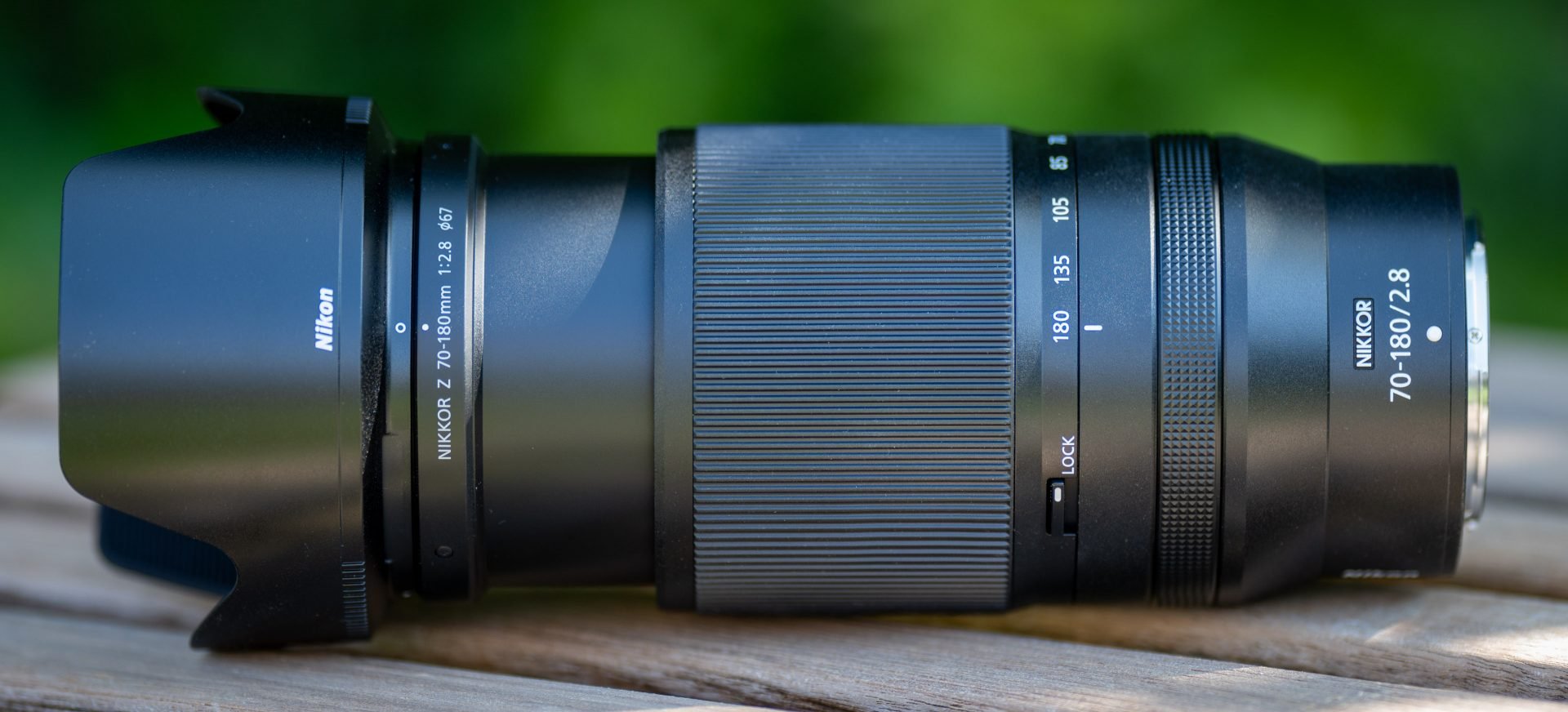
 The Nikon Z 70-180mm f2.8 is a small and light telephoto zoom with a constant f2.8 aperture and corrected for full-frame sensors. It produces pretty good image quality including a soft Bokeh and very usable close-up performance in a package that is around 40% cheaper, 25% shorter, and 45% lighter than Nikon's Z 70-200mm f2.8 VR S. It may not have all the bells and whistles of Nikon's professional zoom lens and certainly does not match its image quality. But the Nikon Z 70-180mm f2.8 still is a compelling alternative and clearly earns a recommendation!
The Nikon Z 70-180mm f2.8 is a small and light telephoto zoom with a constant f2.8 aperture and corrected for full-frame sensors. It produces pretty good image quality including a soft Bokeh and very usable close-up performance in a package that is around 40% cheaper, 25% shorter, and 45% lighter than Nikon's Z 70-200mm f2.8 VR S. It may not have all the bells and whistles of Nikon's professional zoom lens and certainly does not match its image quality. But the Nikon Z 70-180mm f2.8 still is a compelling alternative and clearly earns a recommendation!